Supply Chain Modelling and Simulation: Automotive Case Study Report
VerifiedAdded on 2022/09/07
|7
|1207
|24
Report
AI Summary
This report examines the strategic application of discrete-event simulation techniques within the automotive industry, focusing on enhancing logistics and supply chain management. It presents three distinct case studies: the first analyzes Shanghai Volkswagen Automotive Co. Ltd's use of ARENA simulation to manage market demand and manufacturing capacity, highlighting the benefits of discrete-event simulation in analyzing market forces. The second case study explores GAC Toyota Motor Company's implementation of Enterprise Dynamics software to optimize production lines, emphasizing the importance of coordinated robot and human workforce integration. The third case study investigates the global automotive market's challenges and the use of SIMUL8 software to model market competition and improve performance. The report also references a case study on Atlas Copco's plant in Tierp, Sweden, which uses DES to improve a manual manufacturing plant. Overall, the report emphasizes the utility of simulation software in designing effective logistical strategies and improving competitiveness in the global market.

Simulation 1
Student’s Name
Professor
Date
Student’s Name
Professor
Date
Paraphrase This Document
Need a fresh take? Get an instant paraphrase of this document with our AI Paraphraser
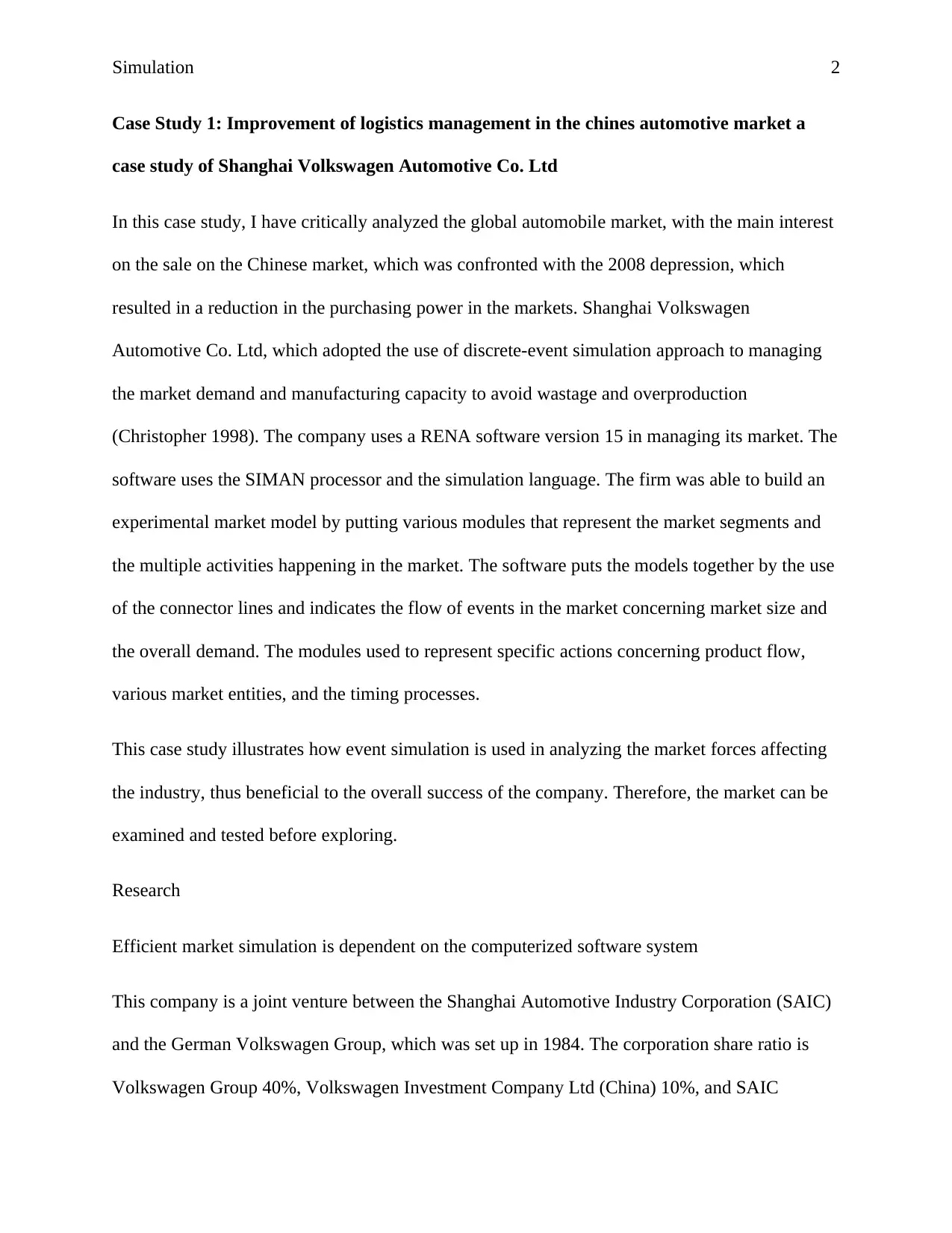
Simulation 2
Case Study 1: Improvement of logistics management in the chines automotive market a
case study of Shanghai Volkswagen Automotive Co. Ltd
In this case study, I have critically analyzed the global automobile market, with the main interest
on the sale on the Chinese market, which was confronted with the 2008 depression, which
resulted in a reduction in the purchasing power in the markets. Shanghai Volkswagen
Automotive Co. Ltd, which adopted the use of discrete-event simulation approach to managing
the market demand and manufacturing capacity to avoid wastage and overproduction
(Christopher 1998). The company uses a RENA software version 15 in managing its market. The
software uses the SIMAN processor and the simulation language. The firm was able to build an
experimental market model by putting various modules that represent the market segments and
the multiple activities happening in the market. The software puts the models together by the use
of the connector lines and indicates the flow of events in the market concerning market size and
the overall demand. The modules used to represent specific actions concerning product flow,
various market entities, and the timing processes.
This case study illustrates how event simulation is used in analyzing the market forces affecting
the industry, thus beneficial to the overall success of the company. Therefore, the market can be
examined and tested before exploring.
Research
Efficient market simulation is dependent on the computerized software system
This company is a joint venture between the Shanghai Automotive Industry Corporation (SAIC)
and the German Volkswagen Group, which was set up in 1984. The corporation share ratio is
Volkswagen Group 40%, Volkswagen Investment Company Ltd (China) 10%, and SAIC
Case Study 1: Improvement of logistics management in the chines automotive market a
case study of Shanghai Volkswagen Automotive Co. Ltd
In this case study, I have critically analyzed the global automobile market, with the main interest
on the sale on the Chinese market, which was confronted with the 2008 depression, which
resulted in a reduction in the purchasing power in the markets. Shanghai Volkswagen
Automotive Co. Ltd, which adopted the use of discrete-event simulation approach to managing
the market demand and manufacturing capacity to avoid wastage and overproduction
(Christopher 1998). The company uses a RENA software version 15 in managing its market. The
software uses the SIMAN processor and the simulation language. The firm was able to build an
experimental market model by putting various modules that represent the market segments and
the multiple activities happening in the market. The software puts the models together by the use
of the connector lines and indicates the flow of events in the market concerning market size and
the overall demand. The modules used to represent specific actions concerning product flow,
various market entities, and the timing processes.
This case study illustrates how event simulation is used in analyzing the market forces affecting
the industry, thus beneficial to the overall success of the company. Therefore, the market can be
examined and tested before exploring.
Research
Efficient market simulation is dependent on the computerized software system
This company is a joint venture between the Shanghai Automotive Industry Corporation (SAIC)
and the German Volkswagen Group, which was set up in 1984. The corporation share ratio is
Volkswagen Group 40%, Volkswagen Investment Company Ltd (China) 10%, and SAIC
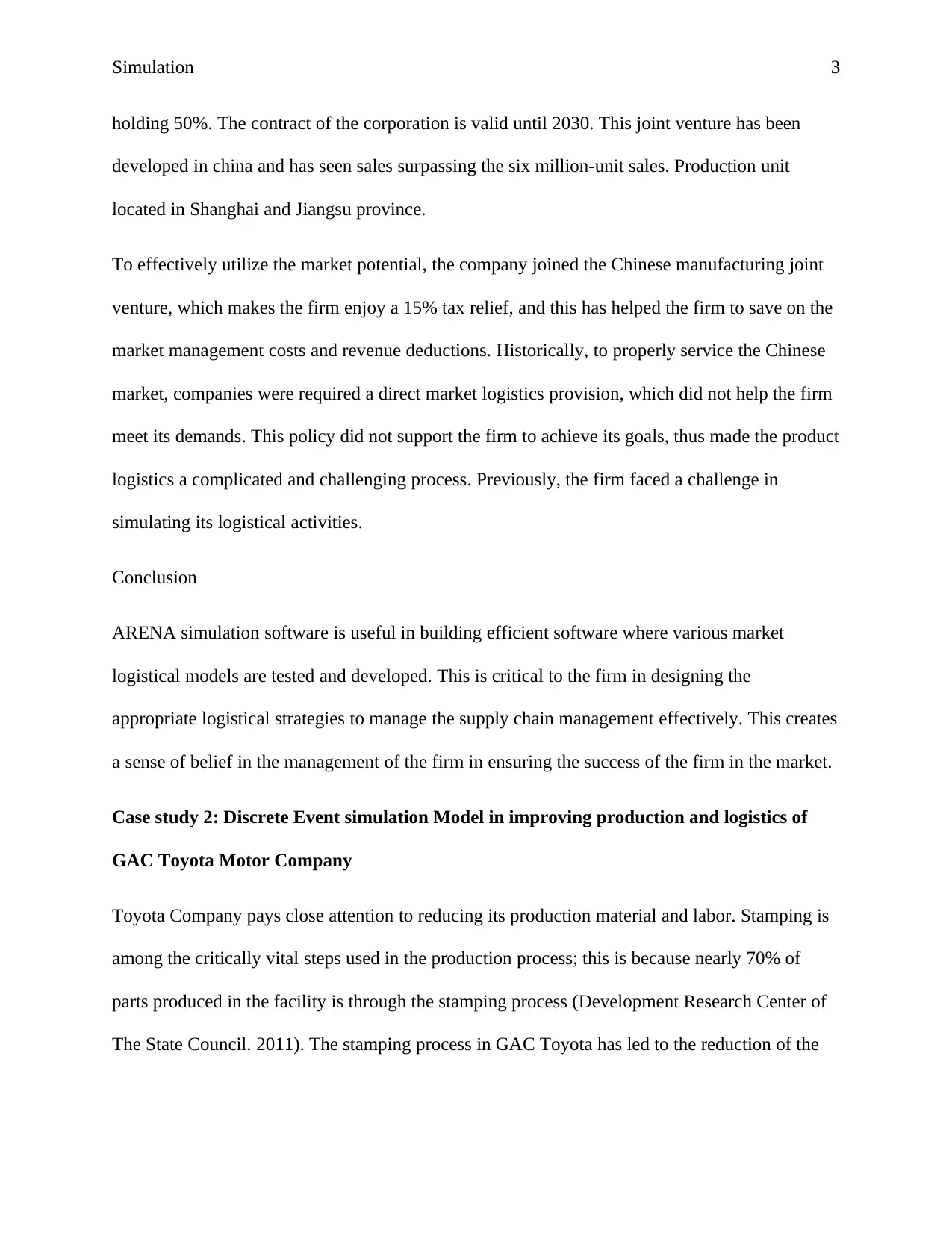
Simulation 3
holding 50%. The contract of the corporation is valid until 2030. This joint venture has been
developed in china and has seen sales surpassing the six million-unit sales. Production unit
located in Shanghai and Jiangsu province.
To effectively utilize the market potential, the company joined the Chinese manufacturing joint
venture, which makes the firm enjoy a 15% tax relief, and this has helped the firm to save on the
market management costs and revenue deductions. Historically, to properly service the Chinese
market, companies were required a direct market logistics provision, which did not help the firm
meet its demands. This policy did not support the firm to achieve its goals, thus made the product
logistics a complicated and challenging process. Previously, the firm faced a challenge in
simulating its logistical activities.
Conclusion
ARENA simulation software is useful in building efficient software where various market
logistical models are tested and developed. This is critical to the firm in designing the
appropriate logistical strategies to manage the supply chain management effectively. This creates
a sense of belief in the management of the firm in ensuring the success of the firm in the market.
Case study 2: Discrete Event simulation Model in improving production and logistics of
GAC Toyota Motor Company
Toyota Company pays close attention to reducing its production material and labor. Stamping is
among the critically vital steps used in the production process; this is because nearly 70% of
parts produced in the facility is through the stamping process (Development Research Center of
The State Council. 2011). The stamping process in GAC Toyota has led to the reduction of the
holding 50%. The contract of the corporation is valid until 2030. This joint venture has been
developed in china and has seen sales surpassing the six million-unit sales. Production unit
located in Shanghai and Jiangsu province.
To effectively utilize the market potential, the company joined the Chinese manufacturing joint
venture, which makes the firm enjoy a 15% tax relief, and this has helped the firm to save on the
market management costs and revenue deductions. Historically, to properly service the Chinese
market, companies were required a direct market logistics provision, which did not help the firm
meet its demands. This policy did not support the firm to achieve its goals, thus made the product
logistics a complicated and challenging process. Previously, the firm faced a challenge in
simulating its logistical activities.
Conclusion
ARENA simulation software is useful in building efficient software where various market
logistical models are tested and developed. This is critical to the firm in designing the
appropriate logistical strategies to manage the supply chain management effectively. This creates
a sense of belief in the management of the firm in ensuring the success of the firm in the market.
Case study 2: Discrete Event simulation Model in improving production and logistics of
GAC Toyota Motor Company
Toyota Company pays close attention to reducing its production material and labor. Stamping is
among the critically vital steps used in the production process; this is because nearly 70% of
parts produced in the facility is through the stamping process (Development Research Center of
The State Council. 2011). The stamping process in GAC Toyota has led to the reduction of the
⊘ This is a preview!⊘
Do you want full access?
Subscribe today to unlock all pages.

Trusted by 1+ million students worldwide
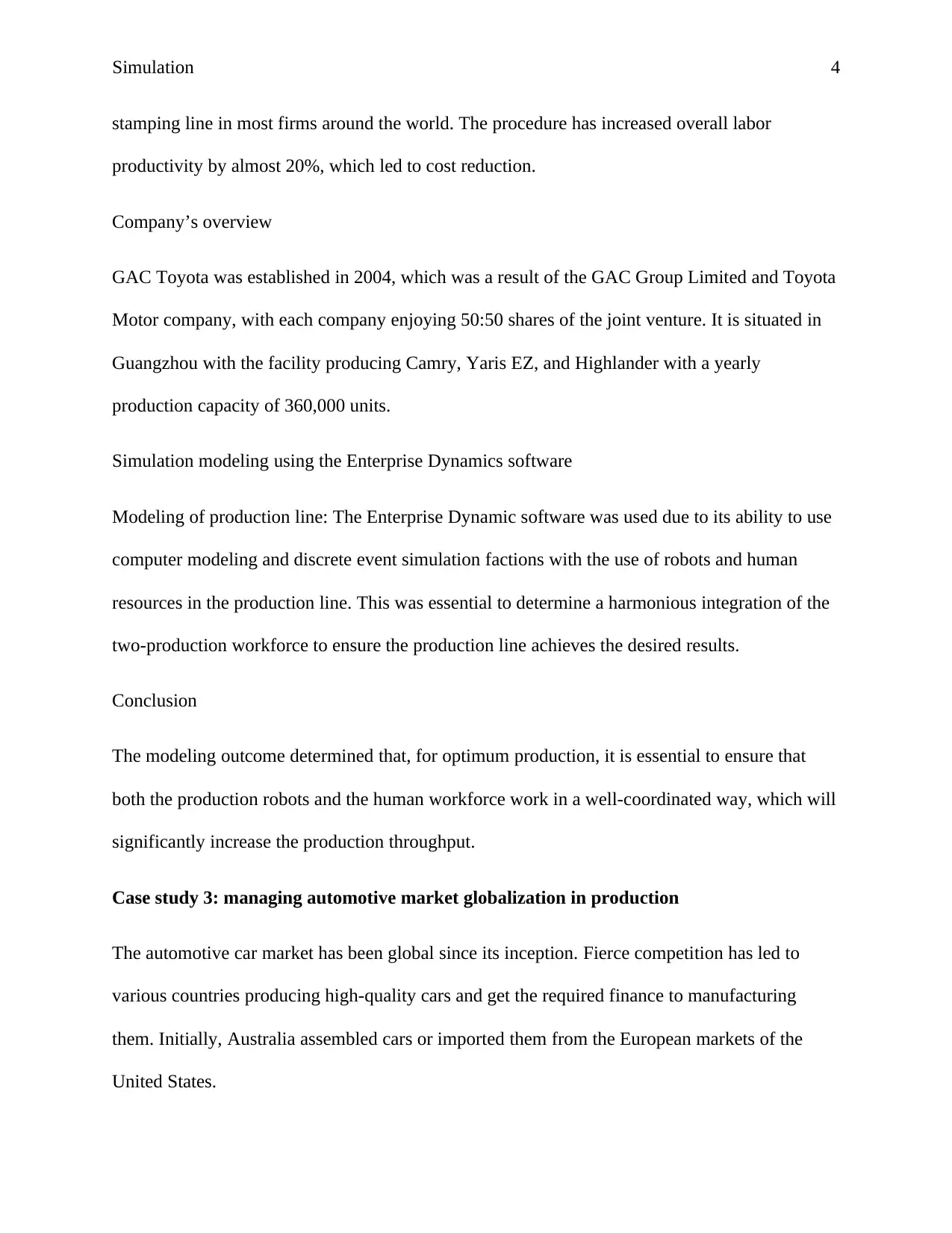
Simulation 4
stamping line in most firms around the world. The procedure has increased overall labor
productivity by almost 20%, which led to cost reduction.
Company’s overview
GAC Toyota was established in 2004, which was a result of the GAC Group Limited and Toyota
Motor company, with each company enjoying 50:50 shares of the joint venture. It is situated in
Guangzhou with the facility producing Camry, Yaris EZ, and Highlander with a yearly
production capacity of 360,000 units.
Simulation modeling using the Enterprise Dynamics software
Modeling of production line: The Enterprise Dynamic software was used due to its ability to use
computer modeling and discrete event simulation factions with the use of robots and human
resources in the production line. This was essential to determine a harmonious integration of the
two-production workforce to ensure the production line achieves the desired results.
Conclusion
The modeling outcome determined that, for optimum production, it is essential to ensure that
both the production robots and the human workforce work in a well-coordinated way, which will
significantly increase the production throughput.
Case study 3: managing automotive market globalization in production
The automotive car market has been global since its inception. Fierce competition has led to
various countries producing high-quality cars and get the required finance to manufacturing
them. Initially, Australia assembled cars or imported them from the European markets of the
United States.
stamping line in most firms around the world. The procedure has increased overall labor
productivity by almost 20%, which led to cost reduction.
Company’s overview
GAC Toyota was established in 2004, which was a result of the GAC Group Limited and Toyota
Motor company, with each company enjoying 50:50 shares of the joint venture. It is situated in
Guangzhou with the facility producing Camry, Yaris EZ, and Highlander with a yearly
production capacity of 360,000 units.
Simulation modeling using the Enterprise Dynamics software
Modeling of production line: The Enterprise Dynamic software was used due to its ability to use
computer modeling and discrete event simulation factions with the use of robots and human
resources in the production line. This was essential to determine a harmonious integration of the
two-production workforce to ensure the production line achieves the desired results.
Conclusion
The modeling outcome determined that, for optimum production, it is essential to ensure that
both the production robots and the human workforce work in a well-coordinated way, which will
significantly increase the production throughput.
Case study 3: managing automotive market globalization in production
The automotive car market has been global since its inception. Fierce competition has led to
various countries producing high-quality cars and get the required finance to manufacturing
them. Initially, Australia assembled cars or imported them from the European markets of the
United States.
Paraphrase This Document
Need a fresh take? Get an instant paraphrase of this document with our AI Paraphraser
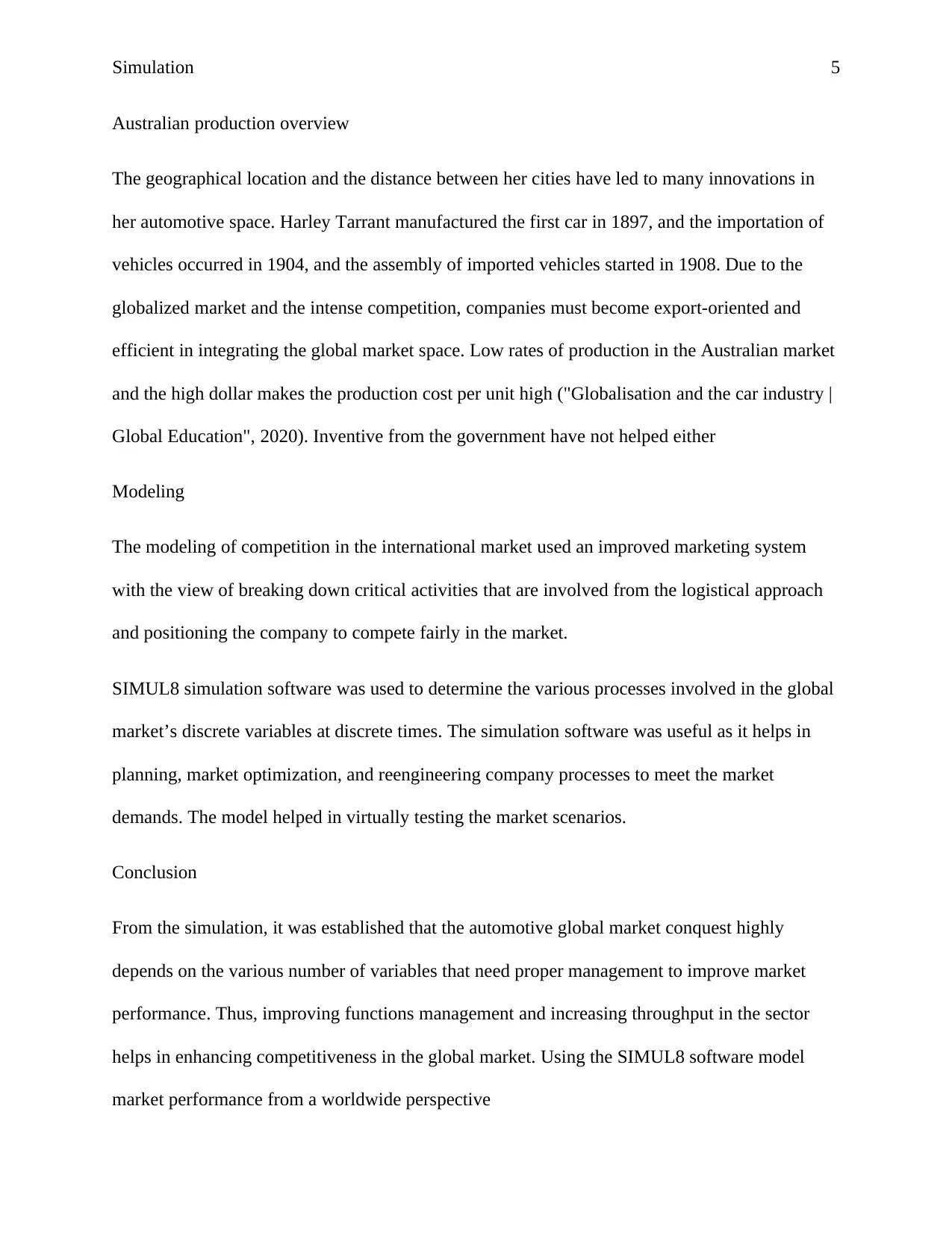
Simulation 5
Australian production overview
The geographical location and the distance between her cities have led to many innovations in
her automotive space. Harley Tarrant manufactured the first car in 1897, and the importation of
vehicles occurred in 1904, and the assembly of imported vehicles started in 1908. Due to the
globalized market and the intense competition, companies must become export-oriented and
efficient in integrating the global market space. Low rates of production in the Australian market
and the high dollar makes the production cost per unit high ("Globalisation and the car industry |
Global Education", 2020). Inventive from the government have not helped either
Modeling
The modeling of competition in the international market used an improved marketing system
with the view of breaking down critical activities that are involved from the logistical approach
and positioning the company to compete fairly in the market.
SIMUL8 simulation software was used to determine the various processes involved in the global
market’s discrete variables at discrete times. The simulation software was useful as it helps in
planning, market optimization, and reengineering company processes to meet the market
demands. The model helped in virtually testing the market scenarios.
Conclusion
From the simulation, it was established that the automotive global market conquest highly
depends on the various number of variables that need proper management to improve market
performance. Thus, improving functions management and increasing throughput in the sector
helps in enhancing competitiveness in the global market. Using the SIMUL8 software model
market performance from a worldwide perspective
Australian production overview
The geographical location and the distance between her cities have led to many innovations in
her automotive space. Harley Tarrant manufactured the first car in 1897, and the importation of
vehicles occurred in 1904, and the assembly of imported vehicles started in 1908. Due to the
globalized market and the intense competition, companies must become export-oriented and
efficient in integrating the global market space. Low rates of production in the Australian market
and the high dollar makes the production cost per unit high ("Globalisation and the car industry |
Global Education", 2020). Inventive from the government have not helped either
Modeling
The modeling of competition in the international market used an improved marketing system
with the view of breaking down critical activities that are involved from the logistical approach
and positioning the company to compete fairly in the market.
SIMUL8 simulation software was used to determine the various processes involved in the global
market’s discrete variables at discrete times. The simulation software was useful as it helps in
planning, market optimization, and reengineering company processes to meet the market
demands. The model helped in virtually testing the market scenarios.
Conclusion
From the simulation, it was established that the automotive global market conquest highly
depends on the various number of variables that need proper management to improve market
performance. Thus, improving functions management and increasing throughput in the sector
helps in enhancing competitiveness in the global market. Using the SIMUL8 software model
market performance from a worldwide perspective

Simulation 6
⊘ This is a preview!⊘
Do you want full access?
Subscribe today to unlock all pages.

Trusted by 1+ million students worldwide
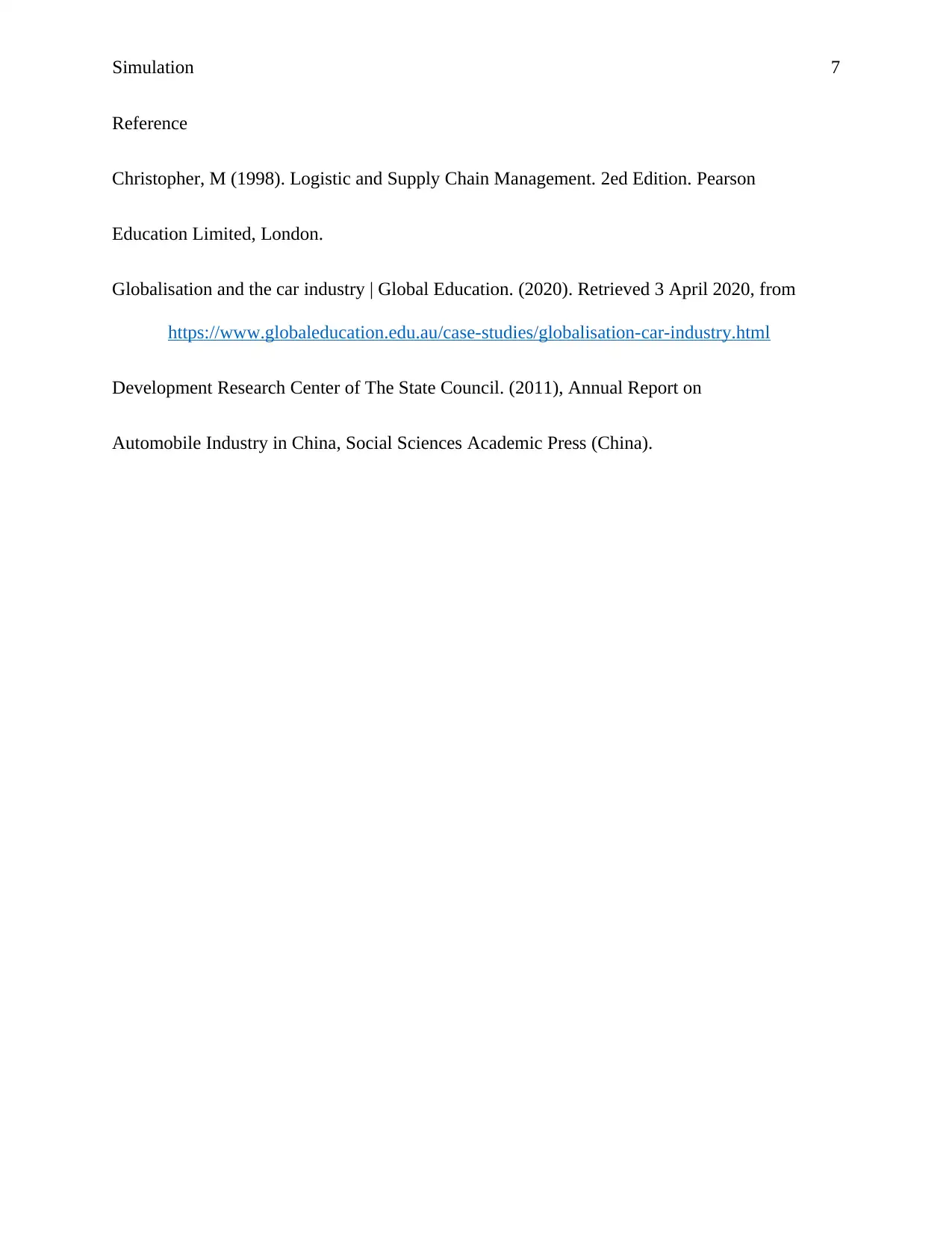
Simulation 7
Reference
Christopher, M (1998). Logistic and Supply Chain Management. 2ed Edition. Pearson
Education Limited, London.
Globalisation and the car industry | Global Education. (2020). Retrieved 3 April 2020, from
https://www.globaleducation.edu.au/case-studies/globalisation-car-industry.html
Development Research Center of The State Council. (2011), Annual Report on
Automobile Industry in China, Social Sciences Academic Press (China).
Reference
Christopher, M (1998). Logistic and Supply Chain Management. 2ed Edition. Pearson
Education Limited, London.
Globalisation and the car industry | Global Education. (2020). Retrieved 3 April 2020, from
https://www.globaleducation.edu.au/case-studies/globalisation-car-industry.html
Development Research Center of The State Council. (2011), Annual Report on
Automobile Industry in China, Social Sciences Academic Press (China).
1 out of 7
Related Documents
Your All-in-One AI-Powered Toolkit for Academic Success.
+13062052269
info@desklib.com
Available 24*7 on WhatsApp / Email
![[object Object]](/_next/static/media/star-bottom.7253800d.svg)
Unlock your academic potential
Copyright © 2020–2025 A2Z Services. All Rights Reserved. Developed and managed by ZUCOL.





